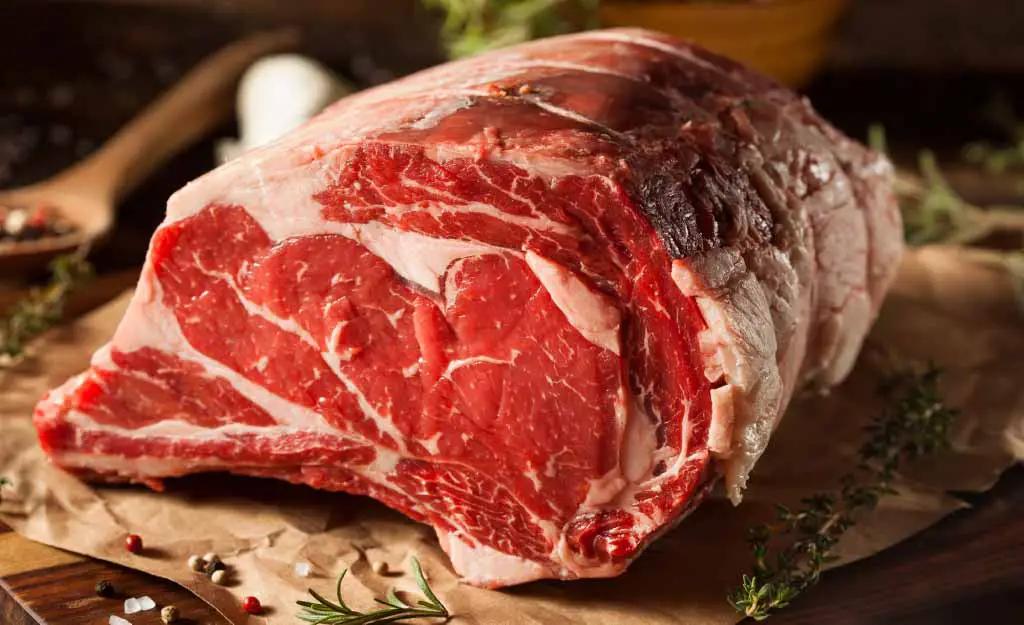Juicy, tender, and flavorful, the Prime Rib is a cut of meat fit for a king. But is this premium cut of beef as easy to find at the grocery store as it is to devour? Luckily, yes!
You can find Prime Rib at the grocery store. However, owing to the high cost of this particular cut of meat, it is usually only available at high-end retailers with a full-service meat department. The Prime Rib may also be sold with alternate names like a Standing Rib Roast or a Beef-Bone-In-Rib-Roast.
Read on as we discuss everything you need to know to find the best Prime Rib at your grocery store!
Ordering Prime Rib at The Grocery Store
While high-end grocery stores may sell a premium cut like the Prime Rib, it is often not found at your local grocer. The reason is simple: the price is too high for the beef cut; thus, it is usually low on demand.
Even at the grocery stores that do sell Prime Rib, it may not be labeled as such, so people often claim they cannot find it at the grocer.
Search for its alternate names if you cannot locate a beef cut precisely named Prime Rib. Try looking for cuts labeled Beef-Bone-In-Rib-Roast, named after the style of cooking of the rib and the place where it’s carved from, or Standing-Rib-Roast, indicative of how the beef is often cooked positioned on the ribs.
Besides these three names, you can simply ask for Rib Roast or Prime Rib Roast at the grocer to purchase this cut. While ordering Prime Rib, you also can select whether you’d like it with bone or boneless.
While boneless rib is easier to carve, keeping the bones in allows for a juicier piece of meat once cooked. This is because the bones act as an insulator keeping the moisture locked in as the meat cooks. However, if you want the bones out, you can ask the butcher to tie the removed bones back with a string onto the meat. This will ensure both easy carving and juicer rib roast.
That’s all there is to order a Prime Rib at the grocery store: ask for the premium cut’s availability and select between bone or boneless. If the grocery store does not carry Prime Rib, your best bet would be to go to your area’s designated butcher’s shop.
What Is The Cost Of Prime Rib?
It’s no secret that Prime Rib is one of the pricier cuts of beef, owing to the quality and taste of the meat. But exactly how much money should you be carrying when you want to buy it?
Depending on USDA grading (more on this below), Prime Rib can cost anywhere between $13 to $17 per pound on average.
From 13 ribs of the cow on each side, numbers 6 to 12 are sold as the Prime Rib. The whole cut of all seven ribs can weigh as high as 22 pounds. Thus you would find them divided in half as the first (6 – 9) and the second (10 – 12) cut.
When buying for a bigger party, follow the general rule of buying 1 pound of meat for each person. Since one bone on average weighs around 2 pounds, you can feed two people per rib. So, do the math before you head out to the grocery store.
Cut vs. Grade: Buying Guide for The Best Prime Rib
Keep in mind that just because a cut of meat is called Prime Rib does not mean it has premium grading. There are, in fact, several qualities of Prime Rib available, all with different price points. Read this definitive guide to ensure you’re paying for the best kind.
Color
The first thing to check when buying a Prime rib is the color. The color of any cut of meat is often the primary indicator of how fresh it is. Red-colored meat, well-marbled with white fat, is what you should seek. A dull, brown color with yellow fat tells you the meat is well past fresh.
A good tip to ensure you pick the freshest cuts of meat is to look for the ones stacked at the back. More often than not, newer cuts with longer shelf life are placed behind in an effort to sell cuts that have been shelved longer.
USDA Beef Grading
The United States Department of Agriculture (USDA) grades beef into three categories based on quality, tenderness, marbling, and usable lean meat. The three categories are divided as follows:
- Prime Beef is the premium meat with abundant marbling from young cattle. These cattle are well-fed and produce meat of the highest quality. However, this grade is pricier and challenging to find at grocery stores.
- Choice Beef has moderate marbling but will still make for excellent quality meat. Tender cuts like ribs will be juicy and flavorful but lackluster when compared to Prime grade.
- Select beef has the least marbling of all three grades. While it can still be tender when cooked right, this grade of meat will have much less flavor than Prime and Choice. However, it also costs less than the two.
Small End vs. Large End
When buying the Prime Rib, one more consideration is to select between the small and large end. Since all seven ribs (6 – 12) can weigh quite a lot, the butcher often divides them into two parts. The ribs closer to the loin end (10 – 12) are called the small end (or first cut), whereas those closer to the chuck (6 – 9) are called the large end (or second cut).
While both of them are excellent for a roast, the small end has more uniform muscle and is deliciously tender when cooked. On the contrary, the large end has various muscles and connective tissues with more fat.
Even though many cooks prefer the small end for its central meat eye, the fatty pockets in the large end add a tremendous amount of nuanced flavor to the dish. So, it really is a matter of preference.
Is Prime Rib Same as The Ribeye?
Despite being cut from the same part of the cow – the ribs – the Prime Rib and Ribeye have one fundamental difference: the Prime Rib is larger with a big bone, more fat, and marbling.
On the other hand, ribeye may often be cut from a comparatively less desirable area of the ribs, thus having less marbling. Therefore, it is usually tougher than the Prime Rib, which is cut from the 7th to 11th rib with ample marbled meat. However, the Prime Rib, essentially a roast, can be cut into ribeyes before the cooking begins.
Since the ribeye has a different texture, it also has another preferred way of cooking than the Prime Rib. The latter is more suited for slow cooking, whereas the ribeye fares well at higher temperatures. This gives the two cuts varying flavors as well.
Overall, the Prime Rib has a ribeye that can be carved before cooking, whereas the ribeye on its own does not have the marbling needed to compete with a premium cut like the Prime Rib.
Which Grocery Store Sells The Best Quality Meat?
If your local grocer does not have the Prime RIb cut, there are several bigger grocery chains you can turn to. However, some offer better quality than others.
The best place to shop for premium cuts of beef is Whole Foods. This supermarket chain promises excellent organic selection, and meat is no exception. Other grocery stores that sell good meat include Publix, Wegmans, and Sprouts.
Read our thorough guide on finding the best meat in grocery stores across the US here.
The Bottom Line
Prime Rib may be expensive, but the perfectly marbled and incredibly tender meat makes it worth the money, especially for special occasions. You can buy it from grocery stores. However, the beef cut’s high price usually limits its availability to high-end grocers. One pound of prime grade Prime Rib can cost approximately $17. Although, you can buy lower grades of Prime Rib at the expense of a richer, more complex flavor. It also has several other names, like the Standing Rib Roast or a Beef-Bone-In-Rib-Roast, so look for these labels at your grocer or ask the butcher to enjoy the most flavorful meal you likely won’t forget for a long time.

